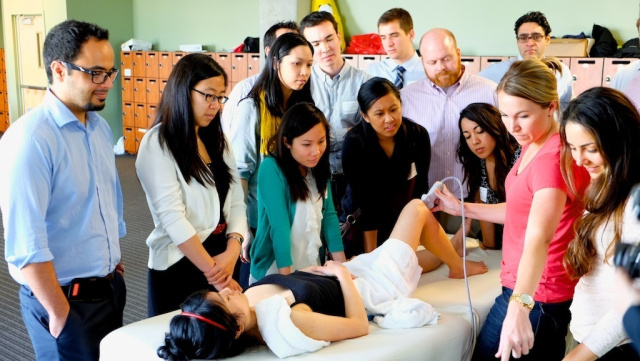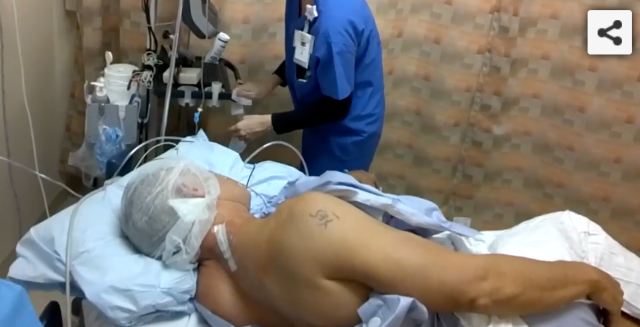mHealthSummit 2014
mHealthSummit 2014, Washington, D.C.
The largest event of its kind, the 5th annual mHealth Summit brings together leaders in government, the private sector, industry, academia, providers and not-for-profit organizations from across the mHealth ecosystem to advance collaboration in the use of wireless technology and to improve health outcomes in the United States and abroad.
Deep connections are made at mHealthSummit. …
From the front lines... Code Black Movie
About Code Black Movie
In his vivid and thought-provoking filmmaking debut, physician Ryan McGarry gives us unprecedented access to America’s busiest Emergency Department. …
What if you could reduce door-to-balloon time for heart attack patients?
Read More from the Experts
PUBMED.gov | 2013 Jul-Sep;17
EMS activation of the cardiac catheterization laboratory is associated with process improvements in the care of myocardial infarction patients
PUBMED.gov | 2010 Apr-Jun
Early cardia …
Interview with Chanel Fishetti - Glimps Show by Fujifilm Sonosite
Chanel Fischetti @Chanel_Fischetti
Chanel Fischetti grew up in Southern California and attended the University of Southern California in Los Angeles where she ran track and cross country. She is currently attending medical school at the University of California Irvine and plans to practice in the field of emergency medicine with a special focus in ultrasound and international health. Outside of medicine, Chanel loves to run, spend time with friends and family and work with the special needs community. …
Dr. Liz Turner discusses Visual Medicine on Sonosite's GLIMPSE show
Lorem ipsum dolor sit amet, consectetur adipiscing elit. Vivamus fringilla mollis varius. Proin est tellus, congue eu sagittis id, suscipit eget mi. Phasellus non ligula vel erat facilisis adipiscing at et ligula. Maecenas eu nisl at magna egestas vestibulum. Fusce ligula leo, hendrerit convallis nibh ac, lobortis vulputate diam. Nullam gravida ac leo nec interdum. Vivamus quis neque quis ligula ultrices euismod. Nulla interdum, lacus luctus rhoncus euismod, velit augue tristique mi, vehicula tristique sem dolor nec lectus. Pellentesque non convallis ipsum. …
Dr. Francis Yamazaki, Discusses Anesthesia on Sonosite's GLIMPSE Show
Lorem ipsum dolor sit amet, consectetur adipiscing elit. Vivamus fringilla mollis varius. Proin est tellus, congue eu sagittis id, suscipit eget mi. Phasellus non ligula vel erat facilisis adipiscing at et ligula. Maecenas eu nisl at magna egestas vestibulum. Fusce ligula leo, hendrerit convallis nibh ac, lobortis vulputate diam. Nullam gravida ac leo nec interdum. Vivamus quis neque quis ligula ultrices euismod. …
Dr. John Christian Fox and Joel Shlang discuss Medical Education, Sonosite's GLIMPSE Show
Lorem ipsum dolor sit amet, consectetur adipiscing elit. Vivamus fringilla mollis varius. Proin est tellus, congue eu sagittis id, suscipit eget mi. Phasellus non ligula vel erat facilisis adipiscing at et ligula. Maecenas eu nisl at magna egestas vestibulum. Fusce ligula leo, hendrerit convallis nibh ac, lobortis vulputate diam. Nullam gravida ac leo nec interdum. Vivamus quis neque quis ligula ultrices euismod. Nulla interdum, lacus luctus rhoncus euismod, velit augue tristique mi, vehicula tristique sem dolor nec lectus. Pellentesque non convallis ipsum. …
Ultrafest UCI 2014 Highlight Film

Ultrafest Ultrasound Festival hosted at UCI (University of California, Irvine) 2014
…
Ultrasound of the Shoulder, Part 1
The American Journal of Orthopedics
Alan M. Hirahara, MD, FRCS(C), and Alberto J. …
Game-Changer
Imaging Economics | September 2011
"Use of ultrasound at the point of care is growing in sports medicine. In office practice and on the playing field, this versatile technology is now widely used by team physicians in professional sports to provide dynamic real-time evaluation and safe, accurate treatment of players' injuries. Most European soccer clubs, as well as the National Basketball Association, are taking advantage of ultrasound's well-established benefits for improving patient safety and outcomes, at a fraction of the cost of MRI or CT scans." Read the full article by Steven Sampson, DO, on the Imaging Economics site. …
Joint Commission and the Risk of Medical Imaging Radiation
The Joint Commission is sending a powerful notice about the radiation risks of diagnostic imaging. Its August 24, 2011, Sentinel Event Alert clearly states that diagnostic radiation can save lives. That is not in dispute. What is at issue is the amount of radiation patients receive over time and the risk for long-term damage.
Over the last 20 years, Americans’ exposure to ionizing radiation has nearly doubled. As the Joint Commission states, “…any physician can order tests involving exposure to radiation at any frequency, with no knowledge of when the last of when the patient was irradiated or how much radiation the patient received.” The World Health Organization’s International Agency for Research on Cancer, the Agency for Toxic Substances and Disease Registry of the Centers for Disease Control and Prevention and the National institute of Environmental Health Sciences all classify x-rays as a carcinogen.
As an Emergency Physician, I recognize the value of x-rays and CT scans and use them when they are medically appropriate. In its Sentinel Event Alert, one of the Joint Commission’s recommended actions is use other imaging modalities when appropriate: “In order to reduce the expose of the patient to ionizing radiation, use other imaging techniques, such as ultrasound or MRI, whenever these tests will produce the required diagnostic information at a similar quality level.” …
Ultrasound Guidance Enables More Difficult Peripheral Vein Access
This Philly.com story on the advantages of ultrasound needle guidance and Thomas Jefferson University Hospital's findings is not only informative but is written in a particularly engageing style accessible to a wide readership. An informed public goes a long way in helping to reinforce the value of clinical ultrasound's multiple benefits.Here is an excerpt from the article by Philadelphia Inquirer staff writer Stacey Burling: …
Astronaut Buzz Aldrin Takes "One Small Step for Scan..."
Ultrasound researcher and Henry Ford Hospital physician Scott Dulchavsky, MD, PhD, was recently inducted into the National Space Technology Hall of Fame for techniques his team developed to empower point-of-care ultrasound. He is working with Sonosite to modify ultrasound training methods developed for the space programme for point-of-care applications on Earth. …
Interscalene Catheter with Google Glass by Dr. Brandon Winchester

A cleverly recorded ultrasound-guided interscalene catheter procedure. The block video was made exclusively with the video camera and microphone built into Google Glass. …
Good News about Healthcare Reform

The Good News About Healthcare Reform: Smarter Use of Imaging Technology Helps Reduce Hospital Errors, Healthcare Costs
Paul Sierzenski, MD …
Reduce Iatrogenic pneumothorax
.fbox {
display: flex;
flex-direction: row;
flex-wrap: nowrap;
justify-content: space-evenly;
align-items: flex-start;
align-content: centre;
}
…
$330 Million Risk: What Boards Should Know

In his article that advises American Hospital Association member trustees, Rodney Hockman, MD warns that hundreds of hospitals are likely to be penalized by Medicare for patient injuries under the Hospital-Acquired Condition (HAC) Reduction Program starting in October 2014. He points out that each penalized hospital stands to lose nearly $434,000 in Medicare reimbursements on average, with large hospital systems and those with a high volume of Medicare payments potentially facing much greater losses should they provide unsafe care.
Dr. Hochman points to institutions using a bundle of best practices to address this, including 353-bed White Memorial Hospital, part of the Adventist Health System in Los Angeles, to eliminate two of the serious complications used to determine penalties under Medicare’s HAC Reduction Program: pneumothorax and central line-associated bloodstream infections (CLABSIs). Both conditions are now included on AHRQ’s list of patient safety indicators. …
Smarter Use of Imaging Technology: Reduce Errors Costs
Medical errors continue to be a major problem in the US healthcare system, with hospital acquired infections (HAC) becoming an area of greater focus and where significant financial penalties are being incurred. Medicare has added one especially dangerous--or even potentially fatal--adverse event, iatrogenic pneumothorax during central line placement, to its HAC list. Along with putting patients in peril, the mistake can also increase hospital costs by up to $45,000 per incident, according to a study by the Agency for Healthcare Quality and Research (AHRQ).
Many excellent studies show that ultrasound guidance can powerfully improve the safety and success of this very common procedure. In fact, in one randomized study of 900 critical care patients, use of ultrasound visualization reduced the rate of collapsed lung during central line placement to zero, compared to 2.4 percent for blind placement.
Dr. Sierzenski is the Director of Emergency, Trauma and Critical Care Ultrasound for Christiana Care Health System’s Department of Emergency Medicine. He is also the Chair, Government Policy & Public Relations for the American College of Emergency Physicians Ultrasound Section and a Master's Candidate in Health Quality and Safety at the Jefferson School of Population Health.
…
$330 Million Risk: What Boards Should Know

In his article that advises American Hospital Association member trustees, Rodney Hockman, MD warns that hundreds of hospitals are likely to be penalized by Medicare for patient injuries under the Hospital-Acquired Condition (HAC) Reduction Program starting in October 2014. He points out that each penalized hospital stands to lose nearly $434,000 in Medicare reimbursements on average, with large hospital systems and those with a high volume of Medicare payments potentially facing much greater losses should they provide unsafe care.
Dr. Hochman points to institutions using a bundle of best practices to address this, including 353-bed White Memorial Hospital, part of the Adventist Health System in Los Angeles, to eliminate two of the serious complications used to determine penalties under Medicare’s HAC Reduction Program: pneumothorax and central line-associated bloodstream infections (CLABSIs). Both conditions are now included on AHRQ’s list of patient safety indicators. …

